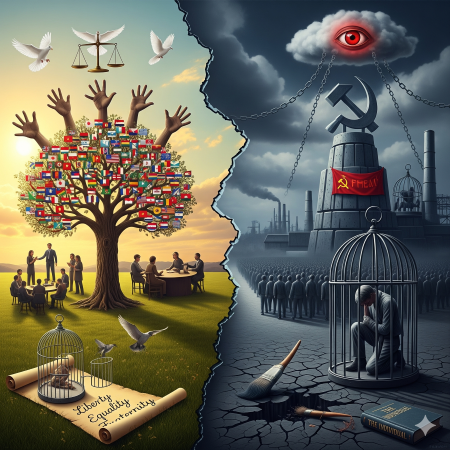Can democracy and communism learn from each other to create hybrid systems of governance?

Democracy and communism can learn from each other, and in fact, various hybrid systems have been theorized and implemented to different degrees.
The goal is to combine the strengths of each—individual liberty and political pluralism from democracy, and social equality and collective welfare from communism—while avoiding their respective pitfalls.
Models of Hybrid Systems
-
Social Democracy: This is arguably the most successful and widespread hybrid model. It maintains a capitalist market economy but uses a democratically elected government to implement a robust social safety net. Think of the Scandinavian countries, which have high taxes to fund universal healthcare, education, and other social services. While not a true communist system (as private property and markets remain dominant), it incorporates the communist ideal of collective welfare and reduced inequality.
-
Democratic Socialism: This model goes a step further than social democracy. While also using democratic means, the goal is to transform the economy from capitalism to socialism. This could involve nationalizing key industries, implementing widespread worker cooperatives, or other forms of social ownership of the means of production. Unlike historical communism, democratic socialists seek to achieve this through elections and reform rather than revolution, and they are committed to upholding democratic rights and civil liberties.
-
Market Socialism: This is an economic model that features social ownership of the means of production but still uses a market system to allocate resources and guide production. The former Yugoslavia had a form of market socialism based on worker self-management. China's "socialism with Chinese characteristics" is another, albeit authoritarian, example of this hybrid, where a one-party state has embraced market mechanisms to spur economic growth.
-
Democratic Confederalism: This is a more radical and decentralized model, often associated with the Kurdish freedom movement. It rejects the nation-state and seeks to build a society based on direct democracy, communal ownership, and ecological principles. Power is vested in local assemblies and councils, and decisions are made through a bottom-up process. While not a state-level system, it's a practical attempt to combine direct democracy with the communist ideals of a stateless, classless society.
These hybrid systems demonstrate that the rigid ideologies of the past can be adapted to create more pragmatic and nuanced forms of governance. They show that it is possible to pursue a more equitable society without sacrificing individual freedoms and to leverage market efficiency without abandoning social responsibility.
This video provides an excellent, easy-to-understand explanation of the differences between social democracy and democratic socialism, two of the most prominent hybrid systems.
Social Democracy and Democratic Socialism Explained EASY
- Questions and Answers
- Opinion
- Motivational and Inspiring Story
- Technology
- Live and Let live
- Focus
- Geopolitics
- Military-Arms/Equipment
- Sicherheit
- Economy
- Beasts of Nations
- Machine Tools-The “Mother Industry”
- Art
- Causes
- Crafts
- Dance
- Drinks
- Film/Movie
- Fitness
- Food
- Spiele
- Gardening
- Health
- Startseite
- Literature
- Music
- Networking
- Andere
- Party
- Religion
- Shopping
- Sports
- Theater
- Health and Wellness
- News
- Culture

